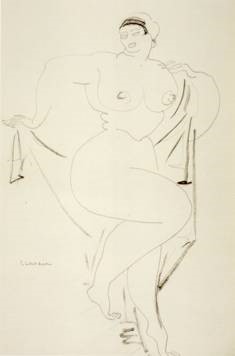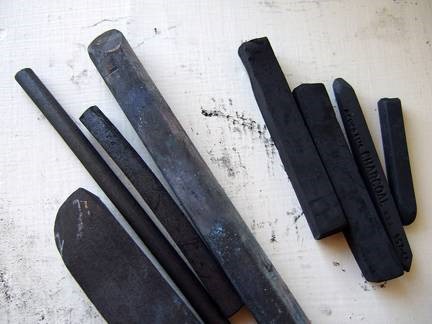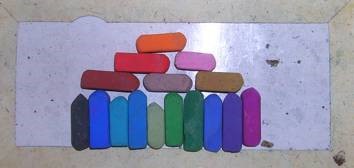Drawing
For centuries charcoal, chalk, graphite and paper have been adequate enough tools to launch some of the most profound images in art. Leonardo da Vinci's The Virgin and Child with Saint Anne and Saint John the Baptist wraps all four figures together in what is essentially an extended family portrait. Da Vinci draws the figures in a spectacularly realistic style, one that emphasizes individual identities and surrounds the figures in a grand, unfinished landscape. He animates the scene with the Christ child pulling himself forward, trying to release himself from Mary's grasp to get closer to a young John the Baptist on the right, who himself is turning toward the Christ child with a look of curious interest in his younger cousin.
The traditional role of drawing was to make sketches for larger compositions to be manifest as paintings, sculpture, or even architecture. Because of its relative immediacy, this function for drawing continues today. A preliminary sketch by the contemporary architect Frank Gehry captures the complex organic forms of the buildings he designs.
Types of Drawing Media
Dry Media includes charcoal, graphite, chalks and pastels. Each of these mediums gives the artist a wide range of mark making capabilities and effects, from thin lines to large areas of color and tone. The artist can manipulate a drawing to achieve desired effects in many ways, including exerting different pressures on the medium against the drawing's surface, or by erasure, blotting or rubbing.
This process of drawing can instantly transfer the sense of character to an image. From energetic to subtle, these qualities are apparent in the simplest works: the immediate and unalloyed spirit of the artist's idea. You can see this in the self-portraits of two German artists; Käthe Kollwitz and Ernst Ludwig Kirchner. Wounded during the first world war, his Self-Portrait Under the Influence of Morphine from about 1916 presents us with a nightmarish vision of himself wrapped in the fog of opiate drugs. His hollow eyes and the graphic dysfunction of his marks attest to the power of his drawing.

Ernst Ludwig Kirchner, Self Portrait Under the Influence of Morphine, around 1916, ink on paper
Graphite media includes pencils, powder or compressed sticks. Each one creates a range of values depending on the hardness or softness inherent in the material. Hard graphite tones range from light to dark gray, while softer graphite allows a range from light gray to nearly black. French sculptor Gaston Lachaise's Standing Nude with Drapery is a pencil drawing that fixes the energy and sense of movement of the figure to the paper in just a few strokes. And Steven Talasnik's contemporary large- scale drawings in graphite, with their swirling, organic forms and architectural structures are testament to the power of pencil (and eraser) on paper.

Gaston Lachiase, Standing Nude with Drapery, 1891. Graphite and ink on paper. Honolulu Academy of Arts
Charcoal, perhaps the oldest form of drawing media, is made by simply charring wooden sticks or small branches, called vine charcoal, but is also available in a mechanically compressed form. Vine charcoal comes in three densities: soft, medium and hard, each one handling a little different than the other. Soft charcoals give a more velvety feel to a drawing. The artist doesn't have to apply as much pressure to the stick in order to get a solid mark. Hard vine charcoal offers more control but generally doesn't give the darkest tones. Compressed charcoals give deeper blacks than vine charcoal, but are more difficult to manipulate once they are applied to paper.

Left: vine charcoal sticks. Right: compressed charcoal squares.
Charcoal drawings can range in value from light grays to rich, velvety blacks. A charcoal drawing by American artist Georgia O'Keeffe is a good example.
Pastels are essentially colored chalks usually compressed into stick form for better handling. They are characterized by soft, subtle changes in tone or color. Pastel pigments allow for a resonant quality that is more difficult to obtain with graphite or charcoal. Picasso's Portrait of the Artist's Mother from 1896 emphasizes these qualities.

Pastels
More recent developments in dry media are oil pastels, pigment mixith an organic oil binder that deliver a heavier mark and lend themselves to more graphic and vibrant results. The drawings of Beverly Buchanan reflect this. Her work celebrates rural life of the south centered in the forms of old houses and shacks. The buildings stir memories and provide a sense of place, and are usually surrounded by people, flowers and bright landscapes. She also creates sculptures of the shacks, giving them an identity beyond their physical presence.
Source: Christopher Gildow, Washington State Board for Community and Technical Colleges, http://opencourselibrary.org/art-100-art-appreciation/ This work is licensed under a Creative Commons Attribution 3.0 License.
This work is licensed under a Creative Commons Attribution 3.0 License.